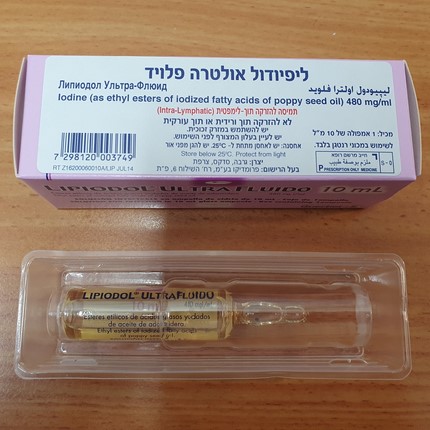Quest for the right Drug

ליפיודול אולטרה פלויד LIPIODOL ULTRA FLUID (IODINE AS ETHYL ESTERS OF IODIZED FATTY ACIDS OF POPPY SEED OIL)
תרופה במרשם
תרופה בסל
נרקוטיקה
ציטוטוקסיקה
צורת מתן:
תוך לימפתי, תוך-עורקי : INTRA-LYMPHATIC, INTRA-ARTERIAL
צורת מינון:
תמיסה להזרקה : SOLUTION FOR INJECTION
עלון לרופא
מינוניםPosology התוויות
Indications תופעות לוואי
Adverse reactions התוויות נגד
Contraindications אינטראקציות
Interactions מינון יתר
Overdose הריון/הנקה
Pregnancy & Lactation אוכלוסיות מיוחדות
Special populations תכונות פרמקולוגיות
Pharmacological properties מידע רוקחי
Pharmaceutical particulars אזהרת שימוש
Special Warning עלון לרופא
Physicians Leaflet
Adverse reactions : תופעות לוואי
4.8. Undesirable effects Most of the adverse reactions are dose-related and consequently the dose should be as low as possible. The use of LIPIODOL ULTRA-FLUID causes a foreign body reaction, with the formation of macrophages and foreign body giant cells and the occurrence of sinus catarrh, plasmacytosis and subsequent connective tissue changes in the lymph nodes. Healthy lymph nodes tolerate the resulting decrease in transport capacity. In case of lesions or hypoplasia of the lymph nodes, these changes may exacerbate existing lymphostasis. Hypersensitivity reactions are possible. These reactions include one or more effects with a concomitant or successive onset, most often including cutaneous, respiratory and/or cardiovascular manifestations, which can each be a warning of an early state of shock and, in very rare cases, can even prove fatal. Cases of pulmonary embolism and cerebral embolism (possibly associated with a cerebral infarction) that are life-threatening or fatal have been reported with LIPIODOL ULTRA-FLUID, for all its therapeutic indications. Diagnostic radiology: • Lymphography: A sharp increase in temperature followed by a fever of 38 to 39°C may occur within 24 hours following the examination. Fat microemboli may occur, with or without symptoms. In very rare cases, they may resemble emboli of organic origin due to their appearance and size. They most often present as punctiform opacities on radiographic images of the lungs. Transient temperature increases are possible. Fat microemboli often occur following an overdose of contrast agent or excessively rapid infusion. Anatomic abnormalities such as lympho-venous fistulas or a decrease in the capacity of the lymph nodes to retain the contrast medium (in elderly patients, or after radiotherapy or cytostatic therapy) make their occurrence more likely. Patients with a right-left cardiac shunt and those with massive pulmonary embolism are particularly exposed to the occurrence of fat microemboli in the brain. Interventional radiology: • Trans-Arterial Chemo-Embolisation: Most adverse reactions are not caused by LIPIODOL ULTRA-FLUID but are due to anticancer drugs or the embolisation itself. The most common adverse reactions of transarterial chemoembolisation treatment are post embolisation syndrome (fever, abdominal pain, nausea, vomiting) and transient changes in liver function tests. Worsening of pre-existing hepatocellular failure may occur following the use of LIPIODOL ULTRA- FLUID in a hepatic intra-arterial procedure and may lead to serious and potentially fatal complications such as hepatic encephalopathy, oedematous ascitic decompensation, hepatic necrosis, liver abscess, pancreatitis, and even necrotising pancreatitis. The adverse reactions are presented in the table below by System Organ Class and by frequency using the following categories: very common (≥ 1/10), common (≥ 1/100 to < 1/10), uncommon (≥ 1/1,000 to < 1/100), rare (≥ 1/10,000 to < 1/1,000), very rare (< 1/10,000), not known (cannot be estimated from the available data). System organ class Frequency: adverse reactions Immune system disorders Frequency not known: hypersensitivity, anaphylactic reaction. Endocrine disorders Frequency not known: hyperthyroidism. Nervous system disorders Frequency not known: cerebral embolism, cerebral infarction, hepatic encephalopathya Respiratory, thoracic and Frequency not known: pulmonary embolism, pulmonary oedema, mediastinal disorders pleural effusion, acute respiratory distress syndrome, pneumonitis Gastrointestinal disorders Frequency not known: vomiting, diarrhoea, nausea, pancreatitisa, ascitesa Hepatobiliary disorders Frequency not known: cholecystitisa, bilomaa, hepatic failurea, hepatic infarctiona General disorders and Frequency not known: fever, pain. administration site conditions Injury, poisoning and Rare: spinal cord injury. procedural complications Frequency not known: fat embolism. Infections and infestations Frequency not known: liver abscessa Skin and subcutaneous tissue Frequency not known: skin necrosisa disorders a : in the context of transarterial chemoembolization (TACE) and transarterial embolisation. Adverse reactions in children The nature of the expected adverse reactions related to LIPIODOL ULTRA-FLUID is identical to that of the effects reported in adults. Their frequency cannot be estimated from the available data. Reporting of suspected adverse reactions Reporting suspected adverse reactions after authorisation of the medicinal product is important. It allows continued monitoring of the benefit/risk balance of the medicinal product. Any suspected adverse events should be reported to the Ministry of Health according to the National Regulation by using an online form: https://sideeffects.health.gov.il/ In addition, suspected adverse events can be reported to the Registration Holder's Patient Safety Unit at: drugsafety@neopharmgroup.com

שימוש לפי פנקס קופ''ח כללית 1994
לא צוין
תאריך הכללה מקורי בסל
01/01/1995
הגבלות
תרופה שאושרה לשימוש כללי בקופ'ח
מידע נוסף
